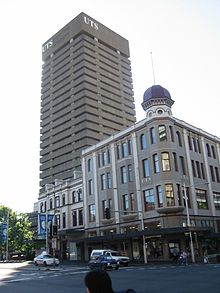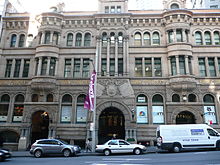|
Arthur Anderson (architect)
Arthur William Anderson (13 May 1868 – 25 June 1942) was an Australian architect active in the last decade of the 19th century and the first 40 years of the 20th century. He was a founder and first president of the Federal Council of the Australian Institute of Architects.[1] Early lifeAnderson was born in Hobart, Tasmania, the son of Maria (née Lipscombe) and William Appleby Anderson and spent his early years in New Zealand. He was educated at Toorak College, Melbourne, and at 12 years of age he commenced senior education at Newington College (1881–1883). His three years at Newington coincided with the headmastership of Joseph Coates.[2] In 1884 Anderson was articled in architecture to A L and G McCredie architects and consulting engineers and in the ensuing five years studied at Sydney Technical College.[3] CareerMethodist ChurchThroughout the 50 years that Anderson worked as an architect in New South Wales, two institutions had a strong influence on his commissions - his church and his school. Anderson was an active Methodist churchman and he did a lot of work for the church. As an Old Newingtonian, Anderson served on the Council of the College, as an honorary architect.[4] he designed churches and halls in Rozelle, Arncliffe, Greenwich, Killara, Wahroonga and Grafton and parsonages in Tighes Hill and Moree.[5]    Sydney HarbourBefore the formation of the Sydney Harbour Trust, Anderson was responsible for the design of the majority of the wharfage premises, including wharves, stores and depots, on the eastern side of Darling Harbour. These included:
All of these buildings have now been demolished with the redevelopment of this area of Sydney Harbour. Department storesAnderson's designs for retail buildings included the Bon Marche store on Broadway for Marcus Clark & Co.[6] and the Mark Foy's store[7] and numerous warehouses. For the Foy family he also designed residences in Waverley, Pymble and Narellan. Offices and warehouses Of the many offices and warehouses designed in Sydney by Anderson, three major examples survive:
Community involvement
See alsoReferences
|
||||||||||||||||
